This easy stir-fried Bulgogi Udon is exploding with flavor and texture! Thinly shaved bulgogi beef meets a bed of wonderfully chewy udon noodles and vegetables in a perfect umami experience. This Japanese-Korean fusion recipe is made of staple Asian ingredients and is sure to leave you coming back for more!
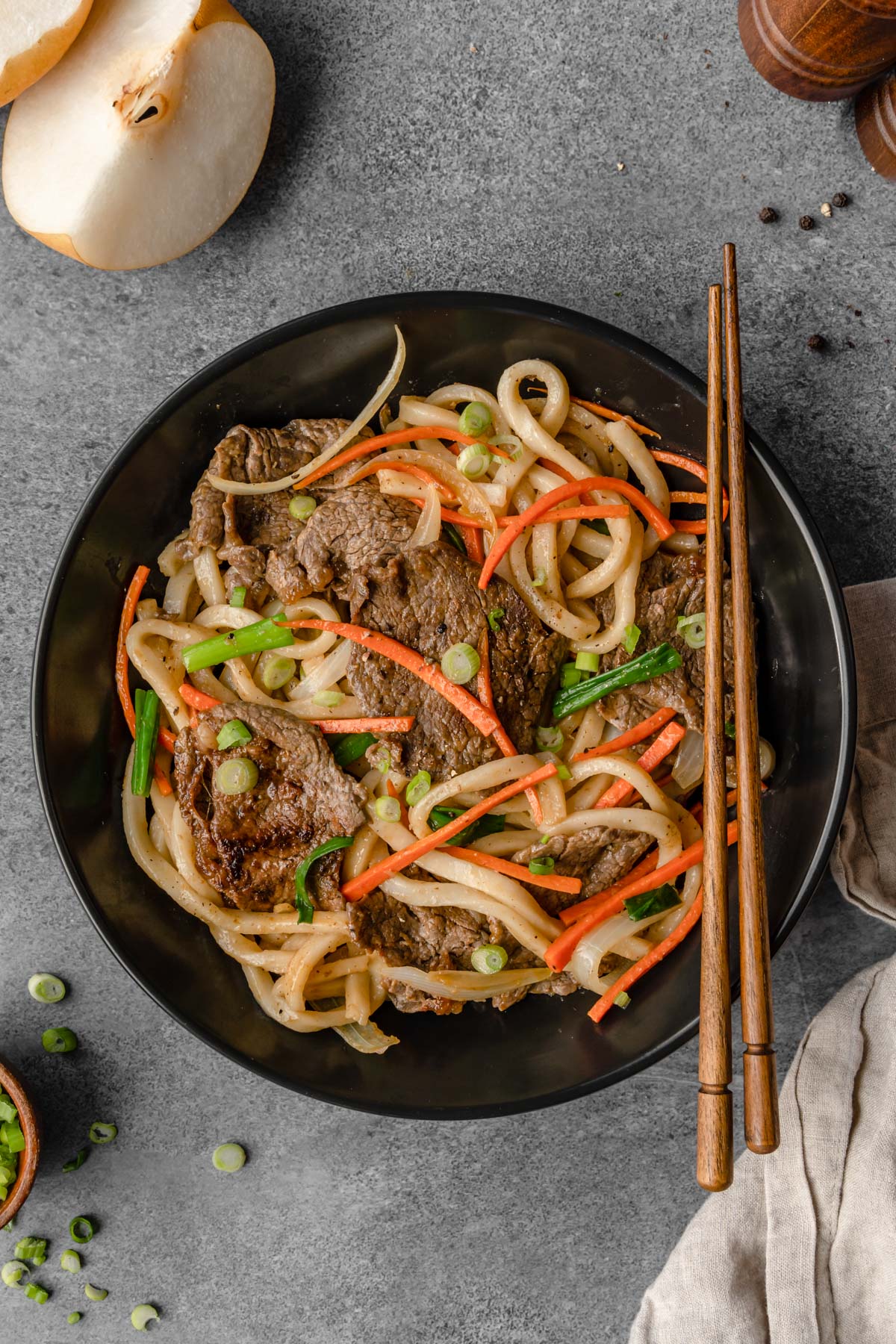
Jump to:
🥢 What is Bulgogi Udon?
Bulgogi (불고기), pronounced “BOOL-goh-gee,” has roots in traditional Korean cooking. It's a sweet and savory marinade used for thinly sliced meat, which is then grilled or charred over high heat. The word bulgogi translates literally as “fire meat.” Authentic bulgogi marinade is made with a blend of fresh vegetables, fruits, and condiments and involves a quick marinade process. When cooked, the marinaded meat becomes wonderfully tender, juicy, and irresistible! The sweet and savory flavor is wonderfully satisfying, which is why bulgogi is almost always found at Korean restaurants and BBQs.
Udon, on the other hand, are thick Japanese noodles used in different yaki (stir fry) or soup recipes - not to be confused with ramen. Ramen noodles are wavy, thin, and yellow wheat noodles. Meanwhile, udon noodles are straight, thick, white wheat noodles made without eggs.
The Best Beef Yaki Udon
Bulgogi Udon fuses both Korean and Japanese styles into one delectable and surprisingly easy meal. The sweet and tender beef melts in your mouth while the chewy udon noodles have the perfect amount of rich and savory flavors. Luckily, stir fry dishes come together effortlessly, so save this recipe for when you need a quick weeknight meal!
Pair this homemade Bulgogi Udon with Tteokkochi (Korean Rice Cake Skewers), Korean Popcorn Chicken, or Gochujang Salmon to impress your family and friends at any get-together. The pop of color in Bulgogi Udon from the carrots and green onion looks fantastic on a table spread, and everyone is bound to come back for seconds!
Why You'll Love It
- Easy: This Bulgogi Udon Stir Fry recipe is easy to follow and only dirties a few dishes. Plus, making your own bulgogi marinade from scratch is surprisingly simple and a staple recipe to have on hand!
- Accessible: Even if you're unfamiliar with the ingredients, Bulgogi Udon uses staple ingredients that can be found at any Asian grocery store. Stock up so you can make this delicious dish anytime!
- Customizable: This Beef Yaki Udon is a super flexible recipe. It's a great option if you’re looking for a kid-friendly recipe or cooking for picky eaters. Even if you change up the noodles or vegetable add-ins, it'll still taste delicious!
🧂 Ingredients
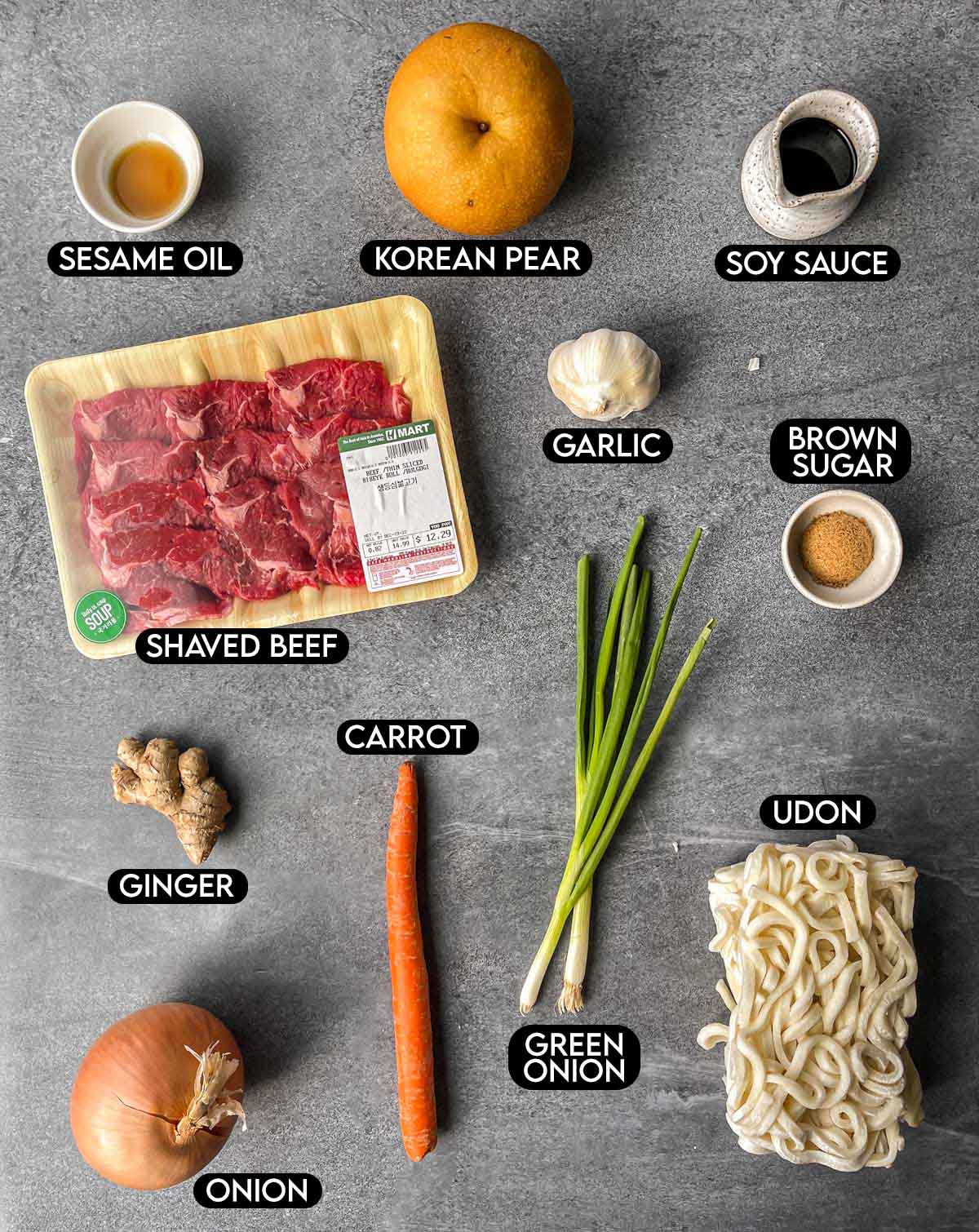
- Shaved beef: You can buy pre-sliced beef or slice your own. The most popular cuts to use in Bulgogi Udon are ribeye and sirloin, but feel free to use more affordable cuts like skirt, flank, flap, or hanger steak. Asian grocery stores also have shaved beef specifically labeled "Bulgogi", which is what I'm using here.
- Udon noodles: These thick, chewy Japanese wheat noodles are my favorite because they're plump and satisfying. Frozen udon noodles have a better texture, cook faster, and will hold up well in stir-fries. However, dry shelf-stable udon are easy to find and will work as well. Make sure to boil it slightly al dente so it doesn't become overcooked.
- Korean pear: Also known as an Asian pear. It's a traditional ingredient in Korean sauces and marinade, and acts as a sweetener and meat tenderizer. You can find them in any Asian markets and I've even had luck finding them at Trader Joe's.
- Carrot and green onion: These two veggies will give the dish a pop of color and add nutrients. Feel free to use shredded carrots for convenience.
- Aromatics: Onion, garlic, and ginger are key flavor components in the marinade.
- Soy sauce: Low-sodium soy sauce will add depth and color to the marinade without overpowering the rest of the ingredients.
- Brown sugar: Lightly sweetens the homemade bulgogi sauce and stir fry. Honey or white sugar would also work.
- Sesame oil: A staple ingredient that will add a pop of nutty flavor and the classic sesame aroma in KBBQ.
- Cooking oil: Avocado oil is my favorite oil to cook, fry, and sauté with because of its high smoke point (500°F) and neutral flavor. However, peanut oil or canola oil will also do the job just fine.
Substitutions & Variations
- While thinly sliced beef is by far the most popular pick for a bulgogi marinade, feel free to switch up the protein. Use sliced chicken, pork, or even ground beef. Each protein should soak up the flavorful marinade in 30 minutes just like the beef.
- Want to save time? Purchase pre-marinaded bulgogi meat at Asian markets and skip ahead to the stir fry.
- I love udon noodles for their bouncy texture, but any noodles can be used. Swap them out with any other long noodles you prefer like ramen, chow mein, or rice noodles.
- If you can't find Korean pear, substitute it with any pear, apple, or kiwi.
- Make a spicy Bulgogi Udon! Add gochujang, red pepper flakes, chili powder, or sriracha to take the heat up a notch.
- Swap out carrots and green onion for your favorite vegetables. Or, simply add to the vegetable count with red bell peppers, sliced mushrooms, bok choy, or baby corn. Any of your favorite stir fry vegetables can be added to this versatile Bulgogi Udon.
- Cooking gluten-free? Swap out the soy sauce for tamari and opt for gluten-free noodles. The texture and flavor profile might shift slightly, but your Beef Udon Stir Fry will still taste great!
👩🏻🍳 How To Make Bulgogi Udon
⬇️ Please scroll down to the recipe card to see full ingredient amounts and instructions.
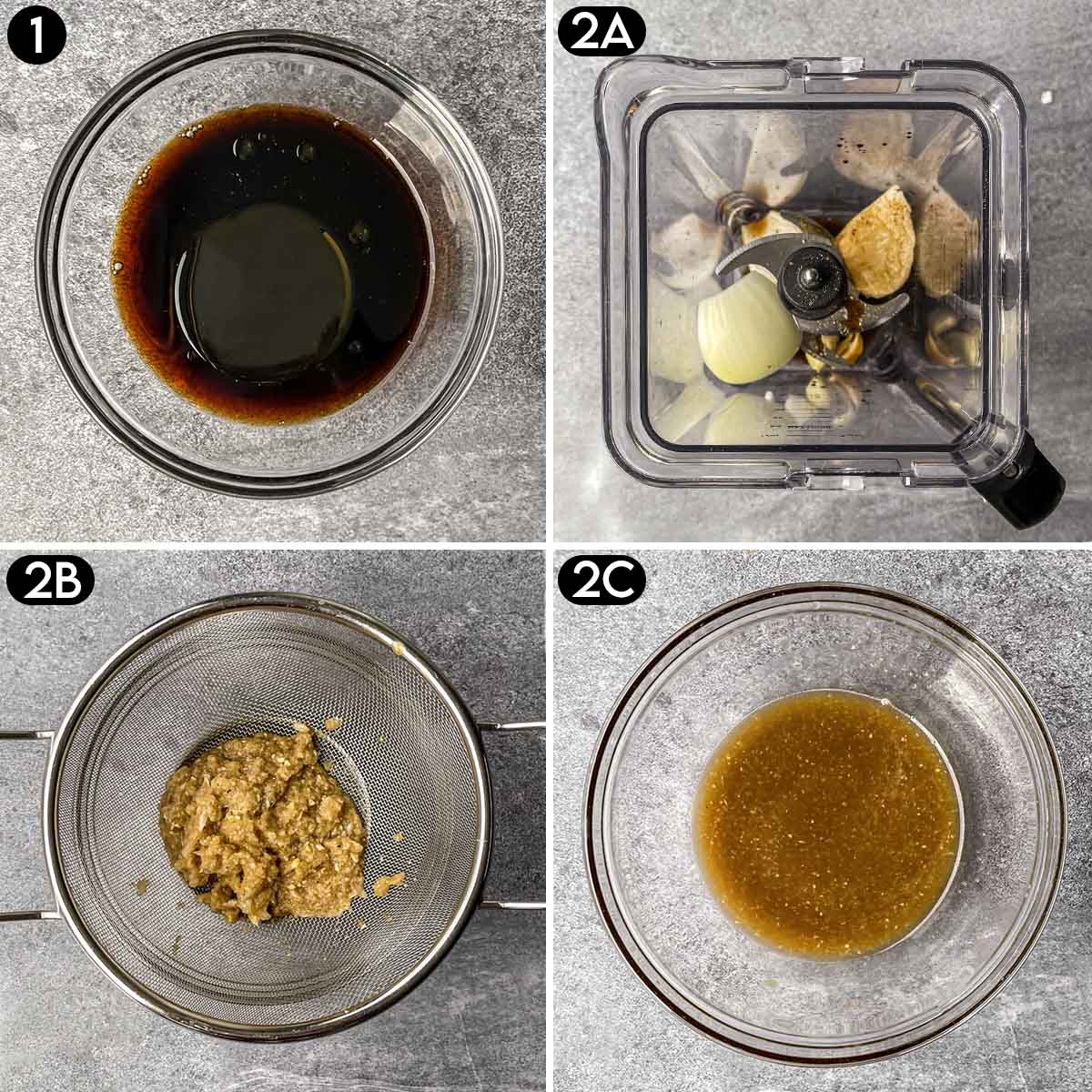
STEP ONE: First, make the sauce. In a small bowl, whisk together soy sauce, brown sugar, and sesame oil.
STEP TWO: To a blender, add Korean pear, onion, garlic, ginger, and 2 tablespoon of the soy sauce mixture. Blend until smooth, then strain. This will prevent the stir fry from becoming mealy.
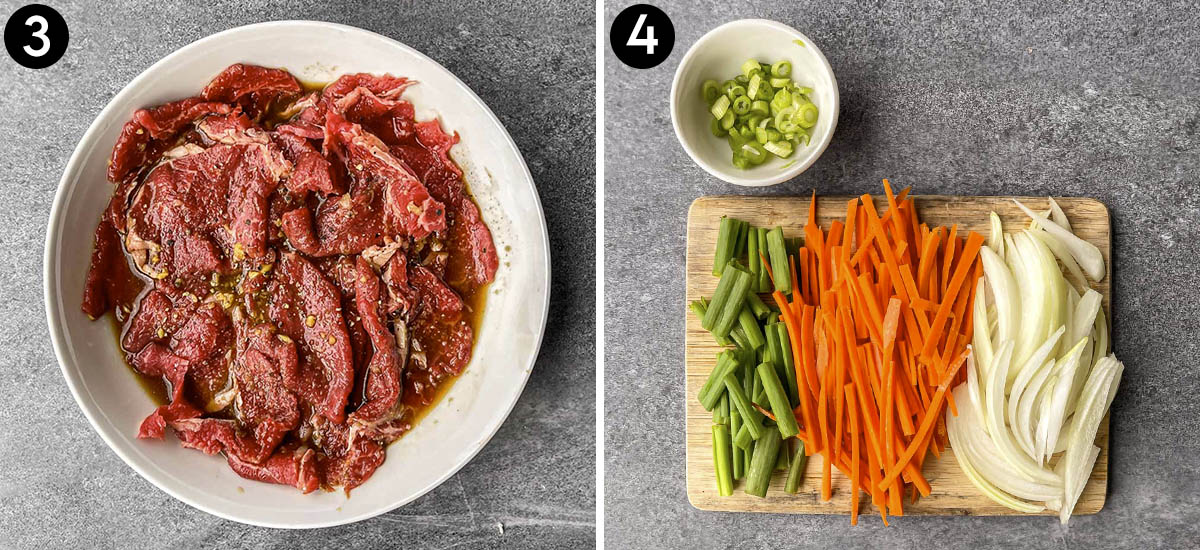
STEP THREE: Next, add the strained marinade to the thinly shaved beef and season with salt and pepper. Let sit for at least 30 minutes, up to overnight. If marinading for more than 2 hours, cover with plastic wrap and store in fridge. Let come to room temperature before cooking and stir occasionally for even marination.
STEP FOUR: While the bulgogi is marinading, chop your vegetables. Thinly slice the onion, julienne the carrots, and divide green onion into thick dark segments and thinly sliced light parts.

STEP FIVE: Have a pot of salted boiling water ready before you begin stir-frying.
Once the beef is done marinading, heat a wok or skillet over high heat and add some oil. Sear the beef, in batches if necessary, until lightly charred but still pink in the middle. Transfer to a plate and set aside.

STEP SIX: Add more oil to the same skillet and turn heat down to medium-high. Add onion and carrot, stir frying for 1-2 minutes until onions are lightly translucent.
STEP SEVEN: Drop the udon into the boiling water, lightly stirring to separate the noodles. Thawed frozen noodles will only need 30-60 seconds, while dry noodles will need a few minutes. Follow package instructions.
STEP EIGHT: Quickly drain the noodles and transfer to skillet, along with remaining soy sauce mixture. Mix thoroughly but gently until noodles absorb sauce, about 1-2 minutes.
STEP NINE: Finally, add beef back in along with dark green onion segment. Mix together for additional minute and season to taste. Garnish with thinly sliced green onion and sesame seeds, and serve the bulgogi noodles immediately.
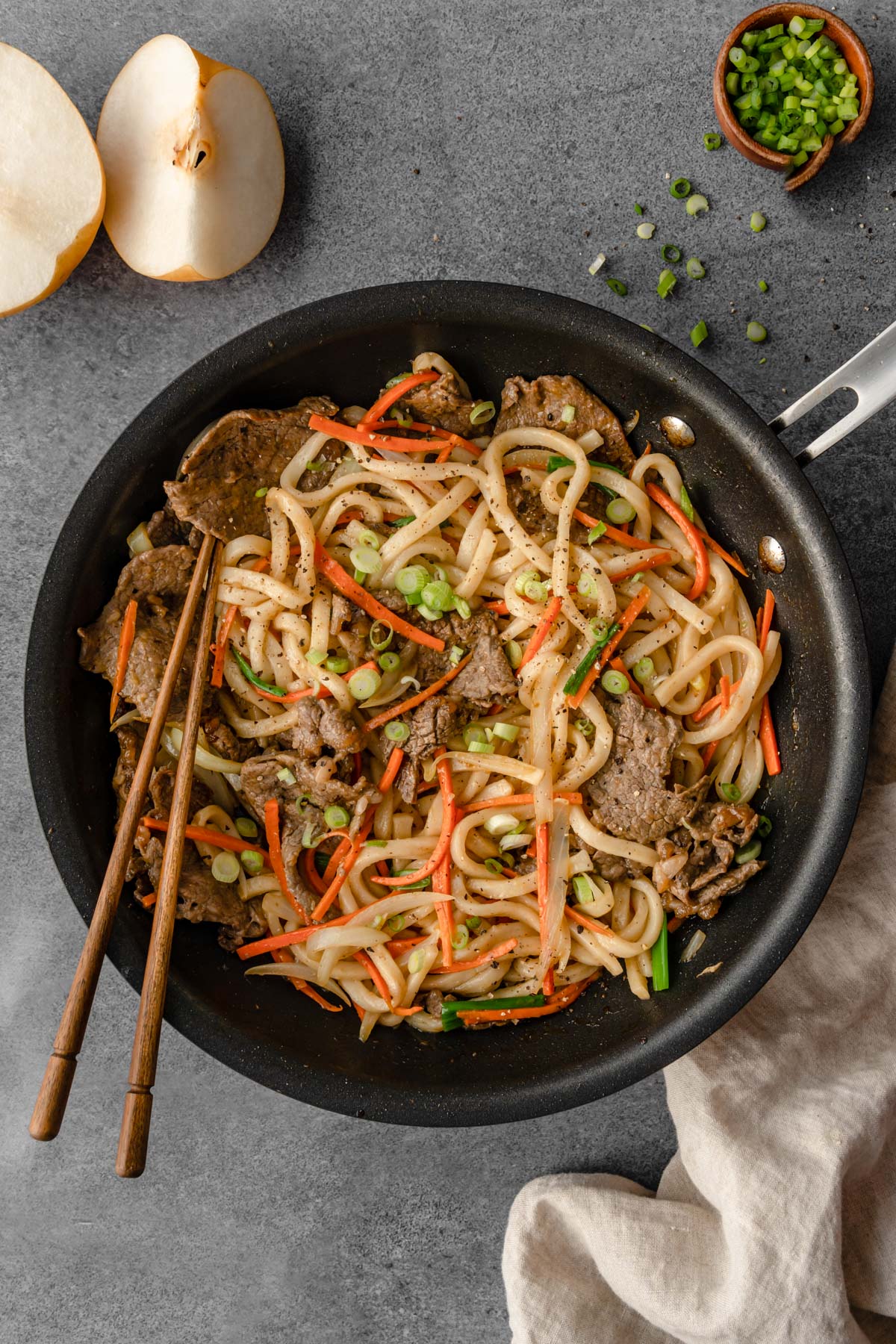
💭 Top Tips
- Some cuts of beef, like flank or round steak, are tougher than others. Add ⅛ teaspoon of baking soda to the marinade to soften the meat. This breaks down the proteins and fibers faster to make the meat more tender.
- Strain the blender marinade to separate the fruit and vegetable pulp. If you include the pulp in the marinade, the beef udon stir fry turns out mealy.
- Have everything for Bulgogi Udon cut and prepped before starting. This includes the pot of boiling water for the udon noodles. Stir fry recipes move very quickly. So, cut back on stress by having everything ready to go before you even begin!
- Par-freeze the beef if you are slicing it yourself. To do so, place the meat in the freezer ½-1 hour before you plan to cut it. Then use a sharp knife to thinly slice against the grain.
- Do not over-boil the noodles. Frozen udon only need 30 seconds in boiling water in order to separate. If you leave them in too long, they become mushy and will disintegrate in the stir fry. Cook dry noodles al dente, about 1-2 minutes less than package instructions. This will prevent them from becoming mushy when stir fried.
🥡 Storing & Freezing
Storing: Let the Bulgogi Udon cool completely before storing. Store in an air-tight container in the refrigerator for 3-5 days.
Freezing: Once fully cooked, I do not recommend freezing Bulgogi Udon. The texture of the cooked noodle will change significantly if frozen. So, it’s best served fresh!
Reheating: Add the leftovers to a pan and stir fry them on medium heat until warm. You can also microwave this dish in 30-second increments, but I recommend warming Bulgogi Udon over a stovetop for the best result.
Make Ahead: Bulgogi beef can be made ahead of time and left to marinate for up to 24 hours. When you’re ready for dinner, simply pull out the marinaded beef and start cooking!

📖 Recipe FAQs
Bulgogi noodles is an Asian fusion dish made with an explosion of flavor. Udon noodles themselves have a fairly mild flavor, but they absorb the flavor of other ingredients really well. Meanwhile, bulgogi marinade has a slightly sweet taste to it. As a result, this dish has the classic sweet taste of bulgogi with just the right amount of sesame and Asian flavors to create an umami masterpiece!
Bulgogi is a marinade that can be used with any meat, but the most commonly picked is beef. Ribeye is the traditional beef used for bulgogi, and sirloin steak is a close second. Whatever cut of beef you choose, make sure to cut it into thin slices to ensure it cooks all the way through.
The main difference between udon and ramen noodles is the fact that udon noodles are vegan, whereas ramen noodles are made with egg. Udon noodles are also much thicker than Ramen noodles and are straight while ramen noodles are thin and wavy.
You can substitute any long wheat noodle in this recipe, but udon noodles are going to give you the best result! If using rice noodles, make sure to rinse them after cooking to remove excess starch as they can be stickier than others.
🍽 Looking For More Asian Recipes?
Love this recipe? Please leave a 5-star 🌟🌟🌟🌟🌟 rating in the recipe card below and consider leaving a comment. It's always greatly appreciated!
📋 Recipe

Bulgogi Udon
Ingredients
Bulgogi Marinade
- ¼ cup low sodium soy sauce
- 1 tablespoon brown sugar tightly packed
- ½ tablespoon sesame oil
- ¼ Korean or Asian pear peeled and cored; about ⅔ cup
- ½ onion
- 3-4 cloves garlic minced
- ½ inch knob ginger grated; about 1 tsp
- ½ lb thinly shaved beef
Udon Stir Fry
- 2 tablespoon cooking oil divided
- ½ onion sliced; about ⅔ cup
- 1 carrot thinly sliced; about ⅔ cup
- 1 lb frozen udon noodles lightly thawed; about 2 packs
- 2 green onion dark green parts chopped into 1" segments and light green parts thinly sliced
- Salt and pepper to taste
Instructions
Marinade Beef Bulgogi
- In a bowl, whisk together soy sauce, brown sugar, and sesame oil.
- Add 2 tablespoon of the sauce to a blender, along with pear, onion, garlic, and ginger. Blend until a paste forms and strain to separate the pulp from the liquid.
- Add the liquid marinade to the beef, along with ¼ teaspoon salt and ¼ teaspoon pepper. Marinade for at least 30 minutes, up to overnight, stirring occasionally.
Stir Fry
- Bring a pot of water to a boil. Have ready on the side while you start on the stir fry.
- Pour 1 tablespoon cooking oil into a wok or large skillet and heat over high heat. When hot, add the beef in a single layer and don't move for 2-3 minutes to let sear. Flip, repeat, and transfer the cooked beef to a clean plate. Cook beef in batches if necessary. Then use a paper towel to clean out the pan.
- Pour remaining oil into the pan and turn heat down to medium-high. Add onion and carrot, letting cook for 1-2 minutes. Meanwhile, drop the udon noodles into the boiling water and stir for 30 seconds to separate. Follow package instructions if using dry, shelf-stable noodles. Quickly drain.
- Add the udon noodles into the pan with the vegetables along with the remaining soy sauce mixture. Stir-fry until noodles absorb the sauce, about 1-2 minutes.
- Add beef and dark green onion segments in and keep stir-frying for an additional minute. Season to taste. Garnish with thinly sliced green onion and serve immediately.
Notes
- Beef: You can buy pre-sliced beef or slice your own. The most popular cuts to use in Bulgogi Udon are ribeye and sirloin, but feel free to use more affordable cuts like skirt, flank, flap, or hanger steak. Asian grocery stores also have shaved beef specifically labeled "Bulgogi", which is what I'm using here.
- Some cuts of beef, like flank or round steak, are tougher than others. Add ⅛ teaspoon of baking soda to the marinade to soften the meat.
- Udon: Frozen udon noodles have a better texture, cook faster, and will hold up well in stir-fries. However, dry shelf-stable udon are easy to find and will work as well. Make sure to boil it slightly al dente so it doesn't become overcooked.
- Substitutions:
- Replace brown sugar with white sugar or honey.
- If you can't find Korean pear, substitute it with any pear, apple, or kiwi.
- Trying to save time? Purchase pre-marinaded bulgogi meat at Asian markets and skip ahead to the stir fry.











Jessica
Stephanie
I love udon noodles and I love bulgogi, so this was the perfect combo! Made some for my dinner and packed the rest for my husbands lunch… and he approved! super easy to make, super filling, and super tasty!!!
Jessica
So glad to hear! Thank you Stephanie!!